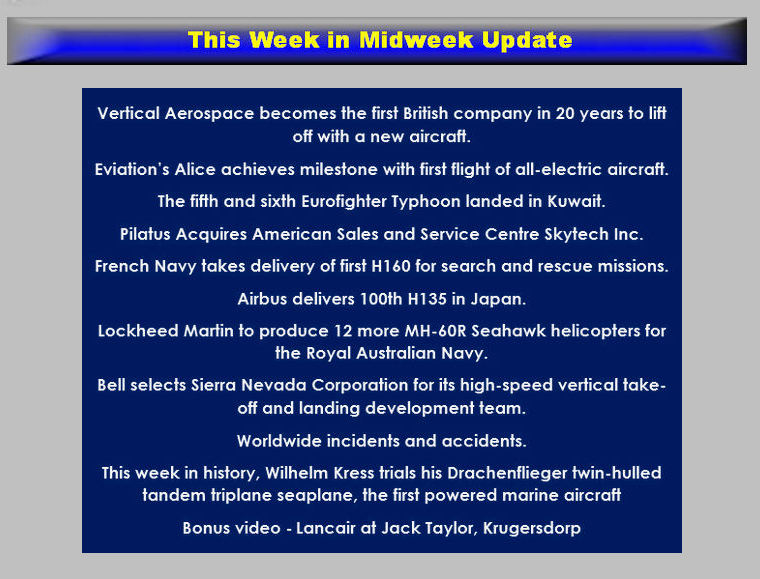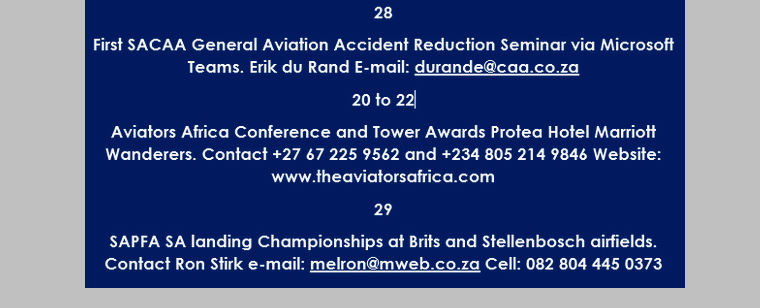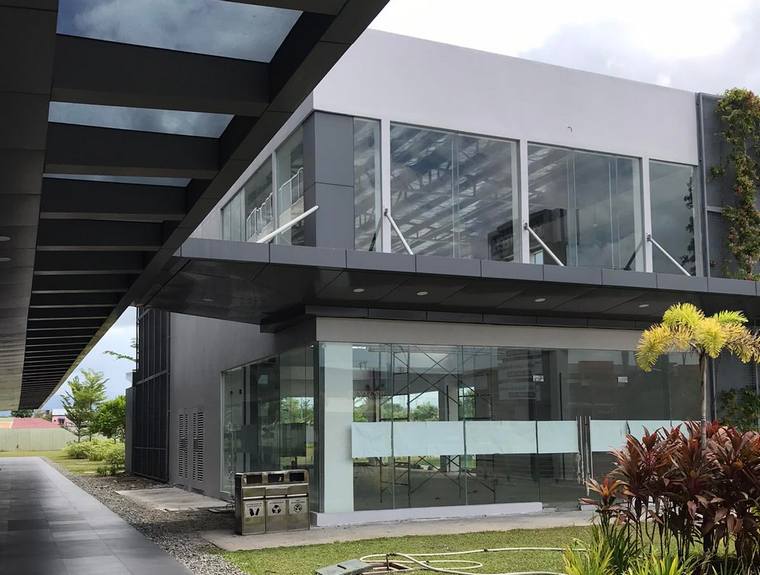


































MIDWEEK UPDATE 6 OCTOBER 2022
Google Banner Ad













Vertical Aerospace (Vertical) [NYSE: EVTL], a global aerospace and technology company that is pioneering zero-emissions aviation, saw its VX4 eVTOL (electric vertical take-off and landing) aircraft recently took-off from the ground for the very first time.
It becomes the first British company to start flight tests with a new aircraft in over 20 years, with its full scale, piloted prototype. The moment marked a significant milestone as Vertical continues to progress successfully through its intensive flight test programme. The programme is expected to continue for several months, completing different stages which will involve reaching higher altitudes and speeds and demonstrating the transition from vertical to horizontal forward flight.
Engineers and flight technicians watched on as Chief Test Pilot, Justin Paines, took the controls for the aircraft's maiden take-off which saw the eight sets of aerodynamic propellers lift the aircraft from the ground at hover-thrust, while tethered to the ground for safety.
The company, unlike many of its competitors, decided to conduct its first flight tests with a pilot on board to prove it could meet the most stringent safety standards. To do this, Vertical Aerospace received regulatory approval in the form of a “Permit to Fly” from the Civil Aviation Authority (CAA), after demonstrating the test could be conducted safely.
The permit and the positive results of these early tests allow the teams at Vertical to progress confidently on their mission to certify the VX4 by 2025. It is hoped the aircraft will carry a pilot and four passengers and is expected to have a range of up to 100 miles with the ability to cruise at speeds of around 150 miles per hour, with a top speed of 200 miles per hour.
The company has already received more than 1,400 conditional pre-orders from some of the world's leading airlines, operators, lessors and tourist groups including Virgin Atlantic, American Airlines, Japan Airlines and Air Asia and recently announced that American Airlines has conditionally committed to make a pre-payment for its first 50 deliveries of the VX4, a strong vote of confidence from the industry.


Alice lifted off at 7:10 a.m. from Grant County International Airport (MWH), flying for 8 minutes at an altitude of 3,500 feet. This trailblazing flight of the technology demonstrator provided Eviation with invaluable data to further optimise the aircraft for commercial production.
“Today we embark on the next era of aviation - we have successfully electrified the skies with the unforgettable first flight of Alice,” said Eviation President and CEO Gregory Davis. “People now know what affordable, clean and sustainable aviation looks and sounds like for the first time in a fixed-wing, all-electric aircraft. This ground-breaking milestone will lead innovation in sustainable air travel, and shape both passenger and cargo travel in the future.”
Alice produces no carbon emissions, significantly reduces noise, and costs a fraction to operate per flight hour compared to light jets or high-end turboprops.
All-electric aircraft will make regional travel more economically and environmentally sustainable for businesses and consumers. This new generation of aircraft has the power to transform communities by providing access to airports not currently used by commercial flights due to noise concerns or restricted operating hours. Eviation Alice is targeted at commuter and cargo marketsand will typically operate flights ranging from 150 miles to 250 miles.
Cape Air and Global Crossing Airlines, both US-based regional airlines, have placed orders for 75 and 50 Alice aircraft respectively. DHL Express is Eviation's first cargo customer, with an order of 12 Alice eCargo planes. With this engagement DHL aims to establish the first electric express network, leading the way for a new era of zero-emissions air freight.
.jpg)
The Eurofighter programme for Kuwait is progressing as expected with successful deliveries. Acceptance activities were completed by a combined effort involving Kuwaiti and Italian personnel from the Joint International Program Office.
Guido Sibona, Vice President of Leonardo's Eurofighter Programme, said: “We are proud to deliver to our customer two more new Eurofighters, including the first single-seater aircraft. They join the aircraft already in service at the new Salem Al Sabah base which in the meantime have reached the milestone of one hundred air sorties. The Eurofighter Typhoons we have developed for the Kuwait Air Force are the most advanced ever produced under the European programme. In cooperation with the Italian Air Force, we are providing the country with a wide-ranging air defence capability, together with the construction of state-of-the-art infrastructure to support and maintenance of a fleet of 28 aircraft.”

One of these two aircraft was recently among the protagonists at the most recent edition of the Royal International Air Tattoo at RAF Fairford in the UK which saw the participation of the Kuwaiti Air Force, for the first time since 1993. On that occasion the pilot, Colonel Eisa Airashidi, commander of the 7th Squadron of the Kuwait Air Force, commented: “This year we are very proud to return to the Royal International Air Tattoo with the most advanced Eurofighter Typhoon in the world. Thanks to the capabilities of this platform, the Kuwait Air Force is one of the best equipped air forces in the region.”
The Eurofighter Kuwait programme is part of a wider and deeper collaboration between the Italian Air Force and the Kuwait Air Force that spans operations, pilot training and support. The Italian Air Force is undertaking initial training, in Italy, of the engineers and technicians who will support the activities of the Typhoon fleet in country.
Leonardo is playing a key role in the evolution of the Eurofighter thanks to the new AESA (Active Electronically Scanned Array) radar that equips the Eurofighter Typhoons for Kuwait, increasing the aircraft's performance and capability.
The Eurofighter Typhoon benefits from a well-defined programme of technological upgrades and enhancements that guarantees cutting-edge capability throughout its entire lifecycle. Constantly evolving technologies, both on board the aircraft and in logistical support, increase operational effectiveness, survivability, and efficient management.

PILATUS ACQUIRES AMERICAN SALES AND SERVICE CENTRE SKYTECH INC.

Founded in 1976, Skytech Inc. is a specialist service provider and aircraft vendor with two locations in the US states of Maryland and South Carolina. As part of an upcoming succession plan, Pilatus has decided to take over Skytech, and the entire workforce of 120 or so will continue to be employed by the Swiss aircraft manufacturer.
Skytech has operated as a Pilatus independent Authorised Sales & Service Centre since 1993. With a successor due to replace co-founder and owner John Foster, Pilatus has decided to acquire its partner of many years. The business will continue to operate as an independent company with responsibility for servicing and sales of PC-24s and PC-12s on the East Coast, as well as aircraft types from other manufacturers. The Skytech brand will also remain. The current Skytech CEO, Justin Lazzeri, will lead the company into the future with his team, which includes many long-serving employees. Both business locations in Rock Hill (South Carolina) and Baltimore (Maryland) are included in the purchase.
This acquisition will allow Pilatus to expand its direct involvement in the US market, a market of great importance to the company. Pilatus already has a Colorado-based subsidiary, Pilatus Business Aircraft Ltd, which has been in operation for the past 26 years. Acting as the Pilatus general importer and completion centre for North and South America, the subsidiary is also responsible for managing Pilatus' Authorised Sales & Service Centre network, marketing and final assembly work. Direct Sales to fleet and government customers are also handled through the Colorado operation. Assisted by its other sales and service partners, Pilatus will use the acquisition of Skytech to ensure and further improve the continuity and quality of its award-winning customer services on the East Coast of the USA.
Markus Bucher, CEO of Pilatus, commented as follows on the occasion of the signing of the contract:
“The US market is very important for us. It is essential that Pilatus continues to expand its 'footprint'. Through this acquisition, we aim to live up to our claim: 'We create the Pilatus Class!' I'm delighted to have the company and its staff on board with us - Welcome to the Pilatus Family!”

“The delivery of the first H160 to a military customer is a major milestone for the H160 programme”, said Bruno Even, CEO of Airbus Helicopters. “This is the first public service version of the H160 to be delivered worldwide. Furthermore, the delivery takes place soon after two H160s entered into service this summer in Brazil for the private and business aviation segment and in Japan for news gathering missions”, he added. “With this H160 we will strengthen our partnership with the French Navy, delivering the right helicopter for its critical search and rescue missions. Together with our partners, we will also ensure that the H160 is ready when needed”.
In 2020 the French Armament General Directorate (DGA) signed a contract with Airbus Helicopters, Babcock, and Safran for the delivery of four H160s in a search and rescue (SAR) configuration. In 2021, the DGA confirmed an option for two more H160s. The first H160 for the French Navy was delivered to Babcock by Airbus Helicopters in May 2022. It has since then been modified into a light military configuration by Babcock. The modular cabin was also adapted for SAR operations and a Safran Euroflir 410 electro optical system was integrated.
The H160 will gradually start operating from the Lanveoc-Poulmic naval air station (Brittany), Cherbourg airport (Normandy), and the naval air station in Hyères (Provence). The interim fleet of H160s will ensure critical search and rescue missions while awaiting the delivery of the H160M Guépard. In the frame of the French Joint Light Helicopter (Hélicoptère Interarmées Léger: HIL) programme, 169 H160M Guépards are foreseen to replace five types of helicopters in service with the French armed forces. The French Navy's operational feedback with these H160s will benefit the design of the military version of the aircraft and its associated support system.
Babcock, in partnership with Airbus Helicopters and Safran Helicopters Engines, will ensure the highest level of availability for the French Navy and the continuity of SAR operations on the Atlantic and the Mediterranean coasts. Built by Airbus Helicopters, the H160 is certified for the use of night vision goggles, which are necessary for winching operations at night.
The H160, as a next generation medium twin engine aircraft, powered by Arrano engines, is modular by design in order to address missions ranging from offshore transportation, private and business aviation, emergency medical services, and public services.

Since the delivery of the country's first H135 to Toho Air Service in April 1997 for electronic news gathering (ENG) activities, Japanese operators across the country have been tapping into Airbus Helicopters' H135 operational excellence for a variety of missions spanning utility, emergency medical services, law enforcement, media broadcasting, passenger transportation, and training.
“The H135 offers great fuel efficiency, allowing it to fly for longer, and further, benefitting our daily operations. As the aircraft is equipped with an autopilot capability, it greatly reduces the pilots' workload,” said Mr. Fumiya Nakamura, pilot of Mainichi Newspapers.
Japan's need for helicopter emergency medical services (HEMS) continues to grow with operators increasingly calling on the uniquely-suited H135. Nearly 50% of the helicopters deployed nationwide for these life-saving missions are H135s, demonstrating its strong ability to outperform in this sector.
Nakanihon Air, one of the largest Japanese operators, received its 20th H135 aircraft in 2019. The company uses this fleet to perform emergency medical service (EMS) missions at 12 bases nationwide, as well as a press coverage aircraft.
“With life-saving missions and 365 days a year operations, the aircraft needs to be ready at any time. The H135's simple maintenance and parts supply system ensure it can be reliably dispatched,” said Mr. Tsuyoshi Shibata, Corporate Officer of Nakanihon Air. ”The quietness and safety of the Fenestron are also appreciated by many medical professionals during transport operations at emergency sites,” he added.
Tohoku Air Service (TAS) has been operating Airbus Helicopter aircraft since the company was established over 30 years ago. The H135 helps to patrol power lines in order to ensure a stable and reliable supply of electricity.
“We have been operating the H135 since 2008 and schedule 1,000 flight hours per year with our current three aircraft,” explains Mr. Shota Ebisu, Mechanic at TAS. “During the 1,000 flight hours, the H135 requires less inspection; therefore we can expect high aircraft availability. Also, for power line patrol missions, it requires flying in mountainous areas. The H135 provides the safety and stability in low-speed flight, ample power and also flying with the twin engines; these are the reasons for choosing this aircraft,” he added.
Law enforcement is also a sector where the H135 has excelled. As the market leader for light twin-engine helicopters, its compact build, agility and high availability make it an outstanding aircraft for police operations. The National Police Agency of Japan employs 14 H135s for law enforcement operations as well as personnel and VIP transport, goods transportation, disaster relief, as well as a wide area of support operations.

The U.S. Navy has awarded Lockheed Martin (NYSE: LMT) a firm-fixed price contract to produce an additional 12 Sikorsky MH-60R Seahawk® helicopters for the Royal Australian Navy (RAN). Procured via the U.S. Government's Foreign Military Sales agreement, the new aircraft will add a third 'Romeo' squadron of unparalleled capability to the RAN's Fleet Air Arm. Sikorsky is a Lockheed Martin company.
As part of the Australian Government's Project SEA 9100 Phase 1 (Improved Embarked Logistics Support Helicopter Capability), the 12 new MH-60R aircraft will create a common fleet of maritime helicopters supporting all of the RAN's air capable platforms.
“Built upon a decade of partnership with the United States Navy and Lockheed Martin, the MH-60R 'Romeo' multi-mission helicopter provides the Royal Australian Navy with an unparalleled maritime aviation platform,” said Rear Adm. Peter Quinn, Head Navy Capability for the Royal Australian Navy. “The versatility of the MH-60R to conduct a wide range of missions combined with the world-class support provided by our partners was a significant factor in the decision by the RAN to make an additional investment in MH-60R under the SEA 9100 Phase 1 program.”
Lockheed Martin plans to deliver all 12 MH-60R helicopters between mid-2025 and mid-2026. Sikorsky Aircraft Australia Limited in Nowra, New South Wales, currently provides depot level maintenance, supply support and logistics support for Australia's MH-60R helicopter fleet.
“The additional 12 MH-60R SEAHAWK aircraft is a testament to the Royal Australian Navy's commitment to providing their service men and women the right aircraft for their mission needs,” said Capt. Todd Evans, U.S. Navy H-60 multi-mission helicopters program manager. “This effort continues the long-standing partnership between the United States Navy and the Royal Australian Navy.”
The RAN was the first international navy to select the MH-60R helicopter, acquiring 24 aircraft from 2013 to 2016. The Fleet Air Arm's 725 and 816 squadrons based at Nowra have accumulated more than 30,000 flight hours embarked on frigates, destroyers and supply ships.


Bell Textron Inc., a Textron Inc. (NYSE: TXT) company, recently announced that it has entered into a teaming agreement with Sierra Nevada Corporation (SNC), a global aerospace and national security company, for Bell's High-Speed Vertical Take-off and Landing (HSVTOL) aircraft. As part of the collaboration, SNC will specifically support the design and development of mission systems for HSVTOL variants.
Bell's HSVTOL vehicles blend the hover capability of a helicopter with the speed, range and survivability features of fighter aircraft, with low downwash hover capability and jet-like speeds of more than 400 kts. This family of scalable aircraft concepts is designed to carry out USAF and USSOCOM missions across the full spectrum of conflict and political scenarios, including personnel recovery, contested logistics and ISR/Strike.
“In an effort to advance technical maturity and deliver HSVTOL capability to war fighters sooner, Bell is assembling a team of industry-leading partners. We're thrilled to have SNC on board,” said Jason Hurst, vice president, Innovation, Bell. “We've made significant progress in Bell's HSVTOL technology development in 2022 and we look forward to showing this progress in the upcoming year.”
“SNC is delighted to join the Bell's HSVTOL development team, and we are already hard at work to deliver the visionary mission systems that Bell demands for their visionary aircraft,” says Derek Hess, vice president, strategic program business development at SNC. “Our nation's war fighters will benefit from this HSVTOL program's ground-breaking operational capabilities.”
Similar to Bell's innovation development, SNC continues to leverage its mission systems expertise to explore dynamic new opportunities. SNC also supports Bell with additional mission systems expertise for the development of the Bell 360 Invictus for the U.S. Army's Future Attack Reconnaissance Aircraft (FARA) competition.
Bell is currently executing its HSVTOL risk reduction effort and participating in the AFWERX HSVTOL Concept Challenge, a crowdsourcing effort for the United States Air Force (USAF) and United States Special Operations Command (USSOCOM). Bell is one of 11 companies from more than 200 challenge entrants selected to receive market research investments aimed at advancing HSVTOL technology.


SOUTH AFRICA
On 13 May 2021, two pilots and a passenger on-board a PA-32RT-300T aircraft registered ZS-CKM took off from Port Elizabeth Aerodrome (FAPE) with the intention to land at Pietermaritzburg Aerodrome (FAPM).
The flight was conducted under instrument flight rules (IFR) by day and under the provisions of Part 91 of the Civil Aviation Regulations (CAR) 2011 as amended. The flight plan was filed for the flight.
About two hours after take-off, the engine started to lose power and, subsequently, stopped. The pilot in-command (PIC) executed a force landing on a gravel road in Umtentweni, located 50 nautical miles (nm) south-west of FAPM.
The PIC stated that before touch down, they unlocked the doors and assumed the brace position. The aircraft touched down and remained centred on the road. However, during the landing roll, both the left- and the right-side wing tips struck two road sign poles which were approximately 20 metres (m) apart; the wing tips were severed, and the ailerons got detached in the process.
The crew managed to maintain directional control until the aircraft came to a stop.
1.1.4 All occupants on-board were not injured in the accident sequence and the aircraft sustained substantial damage.
After the accident, the engine was removed from the aircraft and was sent to an approved engine workshop for inspection. After the engine was disassembled and inspected, it was found that the engine crankshaft had failed. It was then sent for metallurgical testing.
The metallurgical test results revealed two primary fractures that progressed due to predominant fatigue in the web section of the crankshaft during operation.
Probable Cause and Contributory Factors
The crankshaft broke at two points during flight due to fatigue, resulting in engine stoppage and the subsequent unsuccessful forced landing on the gravel road.
Contributing Factor
The crankshaft was not inspected for wear and condition at every 2000 hours or at 12 years as per the manufacturer's recommendation.

Bulgaria, Bezmer Air Base, Bezmer, Jambol: The pilot of a Bulgarian Air Force Sukhoi Su-25K, operated by 22.ShtAB, lost control when landing at Bezmer Air Base (JAM/LBIA), Bezmer, Jambol. The pilot ejected safely and sustained minor injuries and the aircraft crashed and was destroyed by fire.

Guatemala, Los Cerritos, Joyabaj, Quiché: A Robinson R44 Raven II crashed under unknown circumstances in Los Cerritos, Joyabaj, Quiché. The passenger died and the pilot sustained serious injuries. The helicopter was destroyed.
Israel, Al-Ubeidiya, 6km east of Bethlehem, central West Bank, Palestine: A Fly Synthesis Texan Top Class with one occupant crashed while attempting an emergency landing in an open area near Al-Ubeidiya, 6km east of Bethlehem, central West Bank, Palestine. The pilot was injured and taken to a hospital and the aircraft received substantial damage.

Myanmar ,4 mls N of Loikaw Airport: A Myanmar National Airlines ATR 72-600 (72-212A) with 63 on board was hit by bullets as it was approaching runway 19 at Loikaw Airport, Myanmar. Two bullets penetrated the lower fuselage, one hit the side of the aircraft. One passenger sustained injuries to the cheek.
USA, Hermantown, Saint Louis County, MN: A Cessna 172S Skyhawk SP crashed into a house under unknown circumstances in Hermantown, Saint Louis CountyMinnesota, shortly after take-off from Duluth International Airport (DLH/KDLH). The three people on board died and the aircraft was destroyed. Two people in the house were not injured.


3 OCTOBER 1901
Wilhelm Kress trials his Drachenflieger twin-hulled tandem triplane seaplane, the first powered marine aircraft, in Austria-Hungary. It begins to become airborne when Kress slows and tries to turn to avoid an obstruction, capsizing the aircraft.
It was built by Wilhelm Kress with the assistance of a 5,000-krone grant from Emperor Franz Josef in an attempt to create the first heavier-than-air flying machine. The aircraft was constructed as a large, open-truss structure of steel tubing with three sets of wire-braced monoplane wings placed in tandem along its length. The sets of wings were placed at uneven heights with respect to the major axis of the aircraft to prevent aerodynamic interference between them.[3] The undercarriage consisted of two aluminium pontoons with hardened keels, intended to allow the Drachenflieger to take off from and land on water or ice.
Initial trials on water as early as March 1901 confirmed that the poorer power-to-weight ratio would be a problem. Nevertheless, other elements of the design proved sound, and the Drachenflieger was successfully controlled while taxiing, even against a headwind.
Unable to afford to replace the engine, Kress continued taxiing trials. The last of these was on 3 October on the Wienerwaldsee reservoir at Tullnerbach, in which he was forced to swerve suddenly to avoid a groyne. As a result of the violent manoeuvre, the supports for one of the pontoons failed, causing the Drachenflieger to capsize and sink.
Bonus Video
Lancair at Jack Taylor, Krugersdorp
Google Banner Ad

 |
 |
 Copyright © 2024 Pilot's Post PTY Ltd
The information, views and opinions by the authors contributing to Pilot’s Post are not necessarily those of the editor or other writers at Pilot’s Post.
Copyright © 2024 Pilot's Post PTY Ltd
The information, views and opinions by the authors contributing to Pilot’s Post are not necessarily those of the editor or other writers at Pilot’s Post.